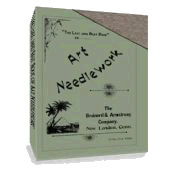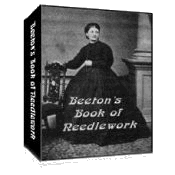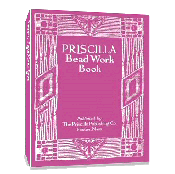Long and Short Stitch
The long and short stitch, which is sometimes called the “tipping Stitch”, lies at the foundation of all solid embroidery, and is the most important stitch to master. It is also one of the oldest stitches to be found in embroidery, as witnessed by the specimens of work handed down from preceding centuries. A pair of embroidery hoops will be found indispensable in order to achieve really good results in this stitch. Have the larger hoop wound with a strip of white cloth until it fits closely over the smaller hoop.
For the first practice, select a flower with a rather large, regular petal, such as a wild rose. After this is stamped, draw your piece of linen smoothly over the smaller hoop, taking care that the thread so the fabric run evenly across, and press the larger hoop over the edges. This should hold the linen firmly stretched. Thread a No. 10 needle with the required shade of single thread, and run the thread in and out through the linen, just inside the petal, bringing the needle up at the tip of the petal, exactly on the line of stamping. Take a long stitch on the upper side of the linen, slanting from the tip toward the center of the flower; bring the needle up again on the outline, close to the first stitch, and take a second stitch on the surface, shorter than the first, and slanting like the first toward the center (see illustration below). This uniform slant will of necessity bring the inner edge of the stitches a little nearer than the outer edge, although there should be no perceptible space between them on the outer edge. Repeat this alternation of long and short stitches until you have completed the outline of one-half the petal. The inner edge of the stitches will be irregular when the work is finished, and will thus appear to blend wit the plain center, giving no sense of incompleteness. The outer edge presents a solid finish. Fasten the thread by running in and out on the under side of the work, doing this neatly, that the under side of the finished work may appear almost as true as the upper.

Click on picture to see more detail.
Begin again at the tip as before, running the thread in the goods, as no knots are permissible in embroidery, and work the opposite side of the petal. Be careful to keep the stitches close and the slant correct. All the long stitches are not to be of the same length, nor all the short stitches, this depends upon the shape of the form to be embroidered, but there should be a regular alternation of “long and short.” If you were embroidering a form which flared instead of growing narrower at the inner edge, the irregular edge of the stitches would be further apart, rather than closer together. The slant must conform to the shape of the petal or form, thus preserving its contour. If both edges were even, the lines would be exactly parallel. A little thought and experimenting will demonstrate this.
It is best, as has been advised, to begin working Long and Short Stitch on a regular petal, but when more advanced work is taken up, it will sometimes be found that petals are represented as though folded. This affects both the shading and the stitch, but only the latter need be dwelt upon here. In this case do not keep the slant of your stitch from the edge toward the center of the flower as stamped, but slant the stitch from the edge in the direction which would reach the center IF THE LEAF WERE LAID OUT SMOOTH (see article on “Directions of Stitches in Turn-over Leaf or Petal).” This is the method by which the folded effect is represented after the embroidery is done, and it is the method by which the folded effect is represented after the embroidery is done, and it is the careful observance of such apparent trifles that gives the artistic touch which removes the work of one individual so far above that of another. The slant of the stitch, taken in connection with the shading, is what gives life to the form embroidered. If these items are not considered, no matter how heavy and smooth the work may be, the result will be flat, and the flowers will look as though pressed out of all semblance to life.
Many of the solid forms, used in designs upon table linen, are tipped in the manner just described, with Long and Short Stitch, instead of being solidly embroidered. The result is good and often better than heavier work, much depending of course upon the style of design. If most of the pattern is in outlines, then one solid figure would be out of place and the result would not be well balanced. If there is heavy work in the remainder of the design, then it would be better to work the larger forms in solid embroidery, in order to throw them into relief. The uses of the Long and Short Stitch are many, and the time spent in learning to work it with a solid, smooth finish will be well repaid.
In embroidering leaves in Long and Short Stitch, begin work at the tip of the leaf, and keep the slant of the stitch toward the mid rib, following the direction of the veins. A folded leaf is embroidered in just the same manner as a folded petal. Work first one side from top to stem, then the other side in like manner.
Conventional or geometrical forms are always flat, but the manner of working is the same as for the floral forms already described, the contour of the figure determining the slant of the stitch and the convergence or divergence of the stitches at their irregular edge.
Return to top of Long and Short Stitch page.
Return to Embroidery Stitches page.
Return to Home page.



 433 pages!
433 pages!

